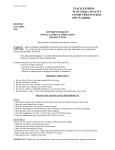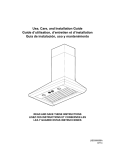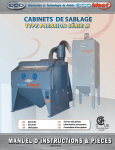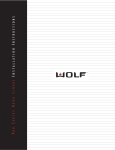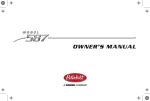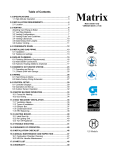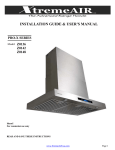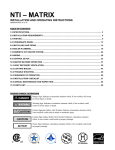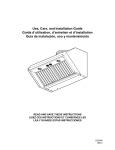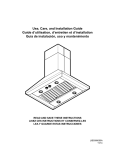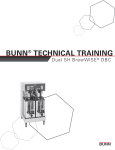Download Dexter Laundry DDAD30HC-59 Series Dryers Operator`s manual
Transcript
8514-201-001PR 03/01/2010 OPERATOR'S MANUAL For DDAD30HC-59 Series Dryers The dryer must not be stored or installed where it will be exposed to water and/or weather and is suitable for use in room temperatures between 5C and 45C. WARNING: For your safety the information in this manual must be followed to minimize the risk of fire or explosion or to prevent property damage, personal injury or death. -Do not store or use gasoline or other flammable vapours and liquids in the vicinity of this or any other appliance. -WHAT TO DO IF YOU SMELL GAS -Do not try to light any appliance. -Do not touch any electrical switch: do not use any telephone in your building. -Clear the room, building or area of all occupants. -Immediately call your gas supplier from a neighbor’s telephone. Follow the gas supplier’s instructions. -If you cannot reach your gas supplier, call the fire department. Installation and service must be performed by a qualified installer, service agency or the gas supplier. You, the purchaser, must post in a prominent location instructions to be followed in the event the user smells gas. Consult your local gas supplier for procedure to be followed if the odour of gas is present. Post the following “For Your Safety” caution in a prominent location: FOR YOUR SAFETY Do not store or use gasoline or other flammable vapours or liquids in the vicinity of this or any other appliance. FOR YOUR SAFETY THIS MACHINE IS FOR DRYING ONLY FABRICS CLEANED IN WATER. To avoid possibility of fire, including spontaneous combustion, do not dry oiled floor mops, items containing foam rubber or similarly textured rubberlike materials or any material on which you have used a cleaning solvent or which contains flammable liquids or solids (such as petrol, kerosene, waxes, etc.) This appliance is not intended for use by persons (including children) with reduced physical, sensory or mental capabilities, or lack of experience and knowledge, unless they have been given supervision or instruction concerning use of the appliance by a person responsible for their safety. Children should be supervised to ensure that they do not play with the appliance. It is important that you read this Manual and retain it for future reference. For service or replacement parts, contact the distributor in your area or: Dexter Laundry, Inc 2211 West Grimes Avenue Fairfield, Iowa 52556 TABLE OF CONTENTS DRYER DIMENSIONS (Figure 1) UNCRATING INSTALLATION CLEARANCE (Figure 2) DRYER EXHAUST SYSTEM (Figure 3) DRYER SHUTDOWN TOUCH PAD LAYOUT (Figure 4) DRYER DEFAULT SETTINGS DRYER FAULT CODES TOUCH PAD DESCRIPTION OPERATING INSTRUCTIONS PROGRAMMING INSTRUCTIONS SERVICING DRYER PREVENTATIVE MAINTENANCE 3 4 5 10 10 11 12 12 13 15 17 23 23 WARNINGS ABOUT USE AND OPERATION It is ABSOLUTELY ESSENTIAL that the dryer be connected to a good earth connection. This is not only for personal safety, but is necessary for proper operation. KEEP SHIELDS, GUARDS AND COVERS IN PLACE. These safety devices are provided to protect everyone from injury. A DRYER SHOULD BE CONNECTED TO POWER FOR THREE (3) MINUTES before it is operated or before a program change is made. Operation or program changes, which occur during this “power up” period, are subject to loss in case of power interruption. After the initial three minutes, all programmed data is protected from power interruptions of any length and the customer’s individual cycle is protected up to 3 seconds. This is done without batteries. LEAVE THE ELECTRICAL POWER TO THE DRYER ON AT ALL TIMES except when necessary for service or other similar activities. The hour meter function adds only full hours to its reading. If the power is shut off every night, any fraction of an hour of time that is on the machine at that time will be lost. Turning the power off every night could also have some effect on the long-term life of the memory after a number of years. Turning power off occasionally won’t affect the unit. THIS DRYER IS EQUIPPED WITH A MANUALLY RESETTABLE OVERTEMPERATURE THERMOSTAT located on the end of the burner housing above the gas valve. Should the dryer cease to operate, refer to your “Service Procedure and Parts Data” book for instructions. CHECK THIS THERMOSTAT WHEN INSTALLING DRYER to assure it is not tripped. Impacts, such as rough handling in shipment, may trip the thermostat. It may be reset by inserting a wooden (nonconductive) pencil or dowel through the guide bushing in the cover. 2 Figure 1, 30# Stack Dryer Dimensions, inches (mm) 3 INSTALLATION AND OPERATING INSTRUCTIONS Note: Before installation, check that the local distribution conditions, nature of gas and pressure, and the adjustment of the appliance are compatible. UNCRATING AND PLACING DRYER Tools Required: 3/4" (19 mm) hex socket & ratchet driver, wood block 4" (100 mm) or 5" (125 mm) thick, a knife and a groove joint pliers, which will open to 1 3/8" (35 mm). 1. Remove and discard the packaging. 2. The crate base is attached to the dryer by (4) cap screws driven upward from below the crate base. Remove the crate base from the dryer, by tipping the dryer sidewise and place the block under the crate base rail in the center of the dryer. Using a ratchet and a 3/4" (19 mm) hex socket, remove and discard the (2) crating bolts from the side, which is raised. Remove the block from under the crate base. Repeat for the other side. 3. Install leveling legs. Using a walking motion, move dryer sideways about 6" (150 mm) off of the crate base. Tip the dryer up and place the block under the edge of the dryer. Thread two leveling legs about two-thirds into the T-nuts on the base from which the crating bolts were removed. Remove the block from under the dryer. With a walking motion, move the dryer completely off the crate base. Discard the crate base. Tip the dryer sidewise, as previously done, and place the block under the edge of the dryer on the raised side. Thread the leveling legs into the nuts as was done for the first side. Slide the unit into the position where it will be installed. Adjust the leveling legs, using the groove joint pliers, to level and align the dryer with adjacent units. DRYER INSTALLATION 1. CODE CONFORMITY: All commercial dryer installations must conform to the local and national codes for the location of installation and ventilation requirements. 2. INSTALLATION CLEARANCES: This unit may be installed at the following alcove clearances. I Left side 0 in. II Right side 0 in. III Back 18 in. (450 mm) clearance is necessary behind the belt guard to allow for servicing and maintenance. IV Front 48 in. (1200 mm) to allow use of dryer. V Top Refer to figure labeled “Vertical Clearance Dimensions”. AB. 0 in. clearance at the top, 4 in. (100 mm) back from the front. 4 VI. Floor However 1/4 in. (6 mm) clearance should be allowed in case the dryer needs moving. C. A 10 in. (250 mm) clearance is required from top at all other points. This unit may be installed upon a combustible floor. Do not obstruct the flow of combustion and ventilation air. Maintain minimum of 1 in. (25 mm) clearance between duct and combustible material. Refer to the installation label attached to the Belt Guard on the rear of the dryer for other installation information and start-up instructions. 3. MAKE-UP AIR. Adequate make-up air (600CFM/DRUM (17 m3/min.), 1200CFM/DRYER (34 m3/min)) must be supplied to replace the air exhausted by dryers on all types of installations. Provide a minimum of 1.5 ft² (0.14 m²) make-up air opening to the outside for each dryer. This is a net requirement of effective area. Screens, grills or louvers, which will restrict the flow of air, must be considered. Consult the supplier to determine the free area equivalent for the grill being used. The source of make-up air should be located sufficiently away from the dryers to allow an even airflow to the air intakes of all dryers. Multiple openings should be provided. NOTE: The following considerations must be observed for gas dryer installations where dry cleaners are installed. The sources of all make-up air and room ventilation air movement to all dryers must be located away from any dry cleaners. This is necessary so that solvent vapours will not be drawn into the dryer inlet ducts. Dry cleaner solvent vapours will decompose in 5 contact with an open flame such as the gas flame present in clothes dryers. The decomposition products are highly corrosive and will cause damage to the dryer(s), ducts and clothes loads. The operation of this appliance may affect the operation of other types of gas appliances, which take their air for safe combustion from the same room. Adequate ventilation must be provided to avoid back flow of gasses from other appliances in the same room. All other gas appliances should be tested with the Dexter dryer in operation and all the windows and doors closed. If in doubt, consult the appliance manufacturer(s). 4. ELECTRICAL REQUIREMENTS. The electrical power requirements necessary to operate the unit satisfactorily are listed on the serial plate located on the back panel of each dryer. The electrical connection should be made to the terminal board in the control box, on the rear of the unit, using copper conductors of 20A minimum capacity. It is absolutely necessary that the dryer be grounded to a known ground. The installation must meet the National Electrical Requirements of the country of installation. Individual 20A circuit breakers for each dryer are required. The installer must provide a disconnect switch, which will interrupt both lines. It may be a local or national requirement to provide an electrical interruption switch visible and accessible from the room in which the dryer is installed. The wiring diagram is located in the control box on the back of the dryer. 5. GAS REQUIREMENTS. The complete gas requirements necessary to operate the dryer satisfactorily are listed on the serial plate located on the back panel of the dryer. This appliance is adjusted for a G20 gas supply; please refer to the table below for country and regulator setting. NATURAL GAS HEAT INPUT GAS FLOW RATE BURNER PRESSURE INJECTOR SIZE 90000 BTU/HR (26.38kW) GROSS 72000 BTU/HR (21.12kW) NET PER DRUM MAX 2.2 m3 PER HOUR PER DRUM 3.5 in. H2O (8.7 mbar)(0.87 kPa) NO. 32 DRILL (2.95 mm) ADJUSTMENT REQUIRED PER COUNTRY COUNTRY CATEGORY SUPPLY PRESSURE Normal / Minimum mbar GB, IE, ES, PT, FI, I2H 20 / 17 AT, IT, DK, SE, GR FR I2Er 20 / 17 DE I2E 20 / 17 NL I2L 25 / 20 REGULATOR SETTING mbar (kPa) 8.7 (0.87) 8.7 (0.87) (G20) / 12.0 (1.20) (G25) 8.7 (0.87) 12.0 (1.20) The inlet gas connection to the unit is ISO 7-RC 3/4 thread. The connection to the appliance 6 shall be made with a flexible hose suitable for the appliance category in accordance with national installation regulations. The size of the piping to supply the dryer should be determined by reference to national installation practice and consultation with the local gas supplier. A joint compound resistant to all fuel gases must be employed in making threaded pipe connections. A 1/8 inch NPT plugged tapping, accessible for test gage connection, must be installed immediately upstream of the gas supply connection to the dryer. A drip tee is provided in the unit gas piping to catch dirt and other foreign articles. All pipe connections should be checked for leakage with soap solution. Never check with an open flame. Note: There are two 9 mm pressure taps, one at the inlet side, one at the outlet side of the gas valve, for use, if it is necessary, to check either pressure. PRESSURE REGULATOR ADJUSTMENT Adjustments should be made by qualified personnel only. 1. With dryer off , unscrew the outlet pressure tap on the gas control valve a half turn and slip pressure gauge tube over nipple. Ensure that screw is retightened after the regulator is adjusted. 2. Remove regulator cap screw to expose regulator adjustment screw. 3. Start the dryer. Using a screwdriver, slowly turn the adjustment until the required burner pressure is indicated on the pressure gauge. Turn adjustment screw clockwise to increase and counter-clockwise to decrease gas pressure to burner. Turn dryer off. 4. Replace pressure regulator cap screw. 5. Remove pressure gauge and retighten pressure tap screw. 7 CAUTION: The dryer and its individual shutoff valve must be disconnected from the gas supply piping system during any pressure testing of that system at test pressures in excess of ½ psig (35 mbar). The dryer must be isolated from the gas supply piping system by closing its individual manual shutoff valve during any pressure testing of the gas supply piping system at test pressures equal to or less than ½ psig (35 mbar). 6. EXHAUST INSTALLATION. (Refer to Figure 3 at the end of section 6.) Exhausting of the dryer(s) should be planned and constructed so that no air restrictions occur. Any restriction due to pipe size or type of installation can cause slow drying time, excessive heat, and lint in the room. From an operational standpoint, incorrect or inadequate exhausting can cause a cycling of the high limit thermostat, which shuts off the main burners and results in inefficient drying. The oval exhaust duct connection near the top of the dryer will accept a compressed 8” round duct. Individual exhausting of the dryers is recommended. All heat, moisture, and lint should be exhausted outside by attaching a pipe of the proper diameter to the dryer adapter collar and extending it out through an outside wall. This pipe must be very smooth on the inside, as rough surfaces tend to collect lint, which will eventually clog the duct and prevent the dryer from exhausting properly. All elbows must be smooth on the inside. All joints must be made so the 8 exhaust end of one pipe is inside the next one downstream. The addition of an exhaust pipe tends to reduce the amount of air the blower can exhaust. This does not affect the dryer operation if held within practical limits. For the most efficient operation, it is recommended that no more than 14 ft (4.25m) of straight 8 in. (200 mm) diameter pipe with two right angle elbows is used for each cylinder. When more than two elbows are used, 2 ft. (600 mm) of straight pipe should be removed for each additional elbow. No more than four right angle elbows should be used to exhaust a dryer. The design of the vent system shall be such that any condensate formed when operating the dryer from cold shall either be retained and re-evaporated or discharged. If the exhaust pipe passes through a wall, a metal sleeve of slightly larger diameter should be set in the wall and the exhaust pipe passed through this sleeve. This practice is required by some local codes and is recommended in all cases to protect the wall. This type of installation should have a means provided to prevent rain and high winds from entering the exhaust when the dryer is not in use. A hood with a hinged damper can be used for this purpose. Another method would be to point the outlet end of the pipe downward to prevent entrance of wind and rain. In either case, the outlet should be kept clear, by at least 24 in. (600 mm), of any objects that would cause an air restriction. Provide a screen or grill over the termination of the exhaust or flue outlet such as will prevent the entry of a ball of 16 mm in diameter while the machine is not operating but will allow entry of a ball 6 mm in diameter while operating. When exhausting a dryer straight up through a roof, the overall length of the duct has the same limits as exhausting through a wall. A rain cap must be placed on top of the exhaust and must be of such a type as to be free from clogging. The type using a cone shaped “roof” over the pipe is suitable for this application. Exhausting the dryer into a chimney or under a building is not permitted. In either case, there is a danger of lint build-up, which can be highly combustible. Installation of several dryers, where a main discharge duct is necessary, will need the following considerations for installation (see Figure 3). Individual 8 in. (200 mm) ducts from the dryers into the main discharge duct should be at a 45-degree angle in the direction of discharge airflow. NOTE: Never install the individual 8" ducts at a right angle into the main discharge duct. The individual ducts from the dryers can enter at the sides or bottom of the main discharge duct. Figure 3 indicates the various round main duct diameters to use with the individual dryer ducts. The main duct can be rectangular or round, provided adequate airflow is maintained. For each individual dryer, the total exhausting (main discharge duct plus duct outlet from the dryer) should not exceed the equivalent of 14 ft (4.27m) and two elbows. The diameter of the main discharge duct at the last dryer must be maintained to exhaust end. NOTE: A small diameter duct will restrict airflow; a large diameter duct will reduce air velocity; both contributing to lint build up. An inspection door should be provided for periodic clean out of the main duct. 9 DRYER SHUTDOWN To render the dryer inoperative, turn off the main gas shut-off valve and disconnect power to the dryer. 10 11 DRYER CONTROLLER FACTORY DEFAULT PROGRAM SETTINGS DRY CYCLE 1 2 3 4 5 COOL DOWN TIME (MINUTES) 5 2 5 2 2 TOTAL CYCLE TIME (MINUTES) 35 20 25 20 25 DRYING DRYER LOAD TEMPERATURE 0 0 ( F) ( C) 180 82 Towels, pads, heavy cotton 170 77 Sheets, blended materials 180 82 Cotton 130 54 Synthetic materials 175 79 Blended materials DRYER FAULT CODES FAULT# FAULT DESCRIPTION F1 Shorted thermostat sensor. F2 Open thermostat sensor. F3 EEPROM corrupted. F4 F5 Gas valve on fault. Temperature fault. ACTION Dryer stops and “F1” flashes on the 4-digit display. When short circuit on sensor input is removed, “LOAd” appears on the 4-digit display and the remaining dry time is reset. Dryer stops and “F2” flashes on the 4-digit display. When a good sensor is connected to sensor input, “LOAd” appears on the 4-digit display and the remaining dry time is reset. Dryer will not start and “F3” appears on the 4-digit display. The power to the dryer must be cycled to reset the controller. Fault should only occur when starting a dry cycle. The drying temperature did not increase 1ºF. in 15 minutes. “F4” will flash on the display and the dry cycle will finish without calling for heat (energizing gas valve). Opening the door or pressing the STOP key will reset the fault and clear the remaining time in the dry cycle. The drying temperature is at least 25ºF. above the temperature setting. “F5” will flash on the 4-digit display and the dry cycle will finish without calling for heat (energizing the gas valve). The power to the dryer must be cycled to reset the controller. 12 TOUCH PAD DESCRIPTION INDICATOR LIGHTS (L.E.D.s) Description Cycle (1 through 5) These L.E.D.s are on solid when a particular cycle is chosen for operation or programming. Gas Valve This L.E.D. is part of the 4-digit numeric display and will be on solid during the drying part of a cycle when the gas valve does not need to be on. The L.E.D. will be blinking when the gas valve needs to be on. The L.E.D. will not be on solid or blinking (off) if the cycle is stopped, complete, in cool down, or terminated. Programming These L.E.D.s are on solid as they are selected during the programming of the dryer controller. Stop This L.E.D. is on solid when either the STOP button is pressed once or the door is opened during an operating cycle. SWITCHES (Pushbuttons) Description Up/Increase Down/Decrease This touch pad switch will increment (increase) dry time, cool down time, and drying temperature. It will also scroll upwards when selecting a dry cycle. This touch pad switch will decrement (decrease) dry time, cool down time and drying temperature. It will also scroll downwards when selecting a dry cycle. This touch pad switch allows the dryer controller to enter the permanent programming mode. Program Select/Enter This touch pad switch will select one of the three variable parts of the dry cycle (dry time, temperature, or cool down) by sequencing through them. Once one of the variable parts of the dry cycle is chosen and changed, this touch pad switch will enter the new (changed) value into the dry cycle program. 13 SWITCHES (Pushbuttons) - continued Description This touch pad switch allows the dryer controller to enter the temporary programming mode. Cycle This touch pad switch will stop the dryer during a dry cycle without clearing the present drying cycle if pressed once. If pressed and released twice, consecutively, the present dry cycle will be cleared. Stop Start This touch pad switch will start the operation of a dry cycle if pressed and released once. Pressing and holding this touch pad switch will display the current temperature of the dryer heat sensor as long as it is held in the depressed position. 4-DIGIT NUMERICAL DISPLAY MESSAGES Message Description LOAd This message is displayed after a dry cycle is complete and the dryer loading door has been opened or the STOP touch pad key on the dryer controller has been pressed and released twice. donE This message blinks immediately after completion of the dry cycle and continues to blink until the stop key on the dryer controller touch pad is pressed or the dryer loading door is opened. Prog This message is displayed when entering the permanent programming mode. .15 This message appears while the dryer is in the heating time of a dry cycle. The decimal point will blink if the output for the gas valve is on, or remain on constantly if the output for the gas valve is not on. The number represents the total time left in the dry cycle (includes cool down time). C02 This message appears when the cool down time of the dry cycle is reached. The letter “C” represents the cool down (non-heating) part of the dry cycle. The number(s) after the letter “C” represent(s) the total time remaining in the dry cycle. F5 This message appears if there is a dryer fault. The letter “F” indicates a fault and the number after the “F” represents the specific fault that has occurred. There are five different faults that can appear (F1 through F5). 14 OPERATING INSTRUCTIONS To dry a load of items, you must choose one of the five-programmed dry cycles. Each of these five dry cycles may be modified in two different ways to match your load. Please refer to the “Permanent Dryer Controller Programming” or “Temporary Dryer Controller Programming” section of this manual. There are two parts to each dry cycle. The first part is the heating time, which is when the gas valve is cycled on and off according to the temperature setting in the dry cycle program. The second part is the cool down time, which is after the heating part of the dry cycle, and is when the cylinder continues to turn, but no heat is applied. There will always be at least two minutes of cool down time for each dry cycle. The maximum amount of cool down time is 60 minutes. The default value of the five dry cycles is shown in the “DRYER CONTROLLER FACTORY DEFAULT PROGRAM SETTINGS” table in this manual. To improve the drying capabilities of this dryer, you should always separate (untangle) the individual articles in your load before using the dryer. In the following instruction steps, things that are displayed on the 4-digit numerical display will be in “quotation marks” and any keys on the dryer controller touch pad that physically need to be pressed will be in CAPITAL AND BOLD LETTERS. 1) Place your untangled load into the dryer cylinder and close the dryer loading door. Notice that the dryer controller 4-digit numerical display should show the word “LOAd”. If it does not show this word, then press and release the STOP touch pad key on the dryer controller twice. 2) Press and release the UP or DOWN arrow touch pad key on the dryer controller to select a dry cycle. 3) Once the desired dry cycle is selected, press and release the START touch pad key. After the dryer controller START touch pad key is pressed, the dryer cylinder will start rotating and the two-digit total dry cycle time, along with a decimal point, will appear on the dryer controller display. The time shown on the dryer controller display will count down to the programmed cool down time. At that time, the display will change from the decimal point and two-digit number to a letter “C” and two digits. The letter “C” represents the cool down portion of the dry cycle. The two digits represent the amount of time remaining in the dry cycle. The two-digit time, shown on the dryer controller display, will count down to zero. When the time decrements to zero, the dryer controller display will flash the word “donE” and the end of cycle tone will sound. At that point, the wrinkle free cycle will automatically begin. This cycle will wait two minutes, if the door is not opened or the STOP touch pad key on the dryer controller is not pressed, and then rotate the cylinder for 10 seconds and stop. This idle time of two minutes and tumble time of 10 seconds 15 will repeat a total of 10 times, at which time the wrinkle free cycle stops. The cylinder will not rotate again until a new dry cycle is started. During the wrinkle free cycle the gas valve will not be operated and there will be no heat applied to the load. The word “donE” will also continue to flash and do so even after the wrinkle free cycle is finished. When the dryer loading door is opened, or the STOP touch pad key is pressed, the word “donE” will change to the word “LOAd” on the dryer controller display. The dryer will then be ready for another dry cycle. During the dry cycle, either pressing the STOP touch pad key on the dryer controller or opening the dryer loading door, will stop the dry cycle and not clear it. If you press the STOP touch pad key on the controller and then open the dryer loading door the dry cycle will not be cleared. However, if you open (or open and close) the dryer loading door and then press the STOP touch pad key on the dryer controller, the present dry cycle will be cleared and the word “LOAd” will appear on the dryer controller display. There are two jumpers and one push button on the component side of the dryer controller printed circuit board. The jumper located at the back right side of the each circuit board controls whether the controller display shows and operates in the Fahrenheit or Celsius mode. This jumper is labeled as TEMP SELECT and has three pins. The back and middle pins are for Celsius and the front and middle pins are for Fahrenheit, which is indicated by the letter C for Celsius and the letter F for Fahrenheit. The other jumper, located at the back middle side of each circuit board controls, is used for choosing either a reversing or non-reversing type of dryer. This jumper is labeled as REV and NON-REV. This jumper must be in the non-reversing position, which are the front and middle pins. If the jumper is in the reversing position, the heating part of the dry cycle will not operate properly. The dryer will not reverse direction either. The push button, which is located at the middle center of each circuit board controls, is used to reset all five of the dry cycles to the factory default settings. It is labeled as DEFAULT SETTINGS. Even the dry cycles that have been modified using the permanent programming procedure will be changed back to the factory default settings when using this push button. This push button must be pressed and held for at least three seconds with power applied to the dryer controller circuit board. If changing a jumper, remove power before moving jumper and then move jumper. Before restoring power, press and hold the DEFAULT SETTINGS pushbutton. Then, restore power and release the DEFAULT SETTINGS pushbutton after three seconds of restoring power. TEMPORARY DRYER CONTROLLER PROGRAMMING 16 The temporary programming mode will allow the change of the stored dry cycle settings in the dryer controller for one complete dry cycle. After the dry cycle is complete, the default settings that existed before the temporary change are restored. The temporary dry cycle can be stopped and cleared at any time during the dry cycle operation. To temporarily change a dryer controller cycle, follow the procedures below. Things that are displayed on the 4-digit numeric display will be in “quotation marks”. Keys on the dryer controller touch pad that physically need to be pressed will be in CAPITAL AND BOLD LETTERS. If, at any time, you want to escape the temporary programming mode while changing the program settings, you can press the STOP key on the dryer controller touch pad if the 4-digit numeric display is not flashing. The SELECT/ENTER key on the dryer controller touch pad can be pressed and released to enter the flashing value shown on the 4-digit numeric display and allow you to escape. If you press and release the STOP key on the dryer controller touch pad, when the 4-digit numeric display is not flashing, the temporary changes to the dry cycle program will be cancelled. The stored dry cycle settings that existed before the temporary change will then be restored. If, at any time, you want to start the temporary dry cycle during the temporary programming mode, press and release the START key on the dryer controller touch pad if the 4-digit numeric display is not flashing. The SELECT/ENTER key on the dryer controller touch pad can be pressed and released to enter the flashing value shown on the 4-digit numeric display and allow you to start the temporary dry cycle. If you start the temporary dry cycle, the 4-digit numerical display will change to the total dry time and count down to 0 as the dry cycle progresses. PROCEDURE 1) Make sure the dryer is not in a dry cycle. The 4-digit numeric display on the dryer controller will show “LOAd” when the dryer is not in a dry cycle. 2) Press and release the UP or DOWN arrow keys on the dryer controller touch pad to chose the dry cycle that you want to change (dry cycle 1 through 5). The dry cycle L.E.D. will illuminate to indicate which dry cycle you are choosing. If you press either arrow key and hold it down, the controller will sequence through the five dry cycles. 3) Press and release the CYCLE key on the dryer controller touch pad once you have chosen the dry cycle you want to change. After you press this key, the programming L.E.D. and the dry time L.E.D. will illuminate. The dry cycle L.E.D. will remain illuminated. The total dry time will also be displayed on the 4-digit numeric display. 4) Press and release the UP or DOWN arrow keys to change the total cycle time. Once either of the arrow keys is pressed, the dry time L.E.D. and the total dry time on the 4-digit numeric display will flash. If you press and hold either arrow key down, you will increment (UP arrow) or decrement (DOWN arrow) through the total dry times available (1 through 60 minutes). This displayed dry time includes the cool down time along with the heated time. To not change the total dry time, do not press the arrow keys to change the total dry time. 5) Press and release the SELECT/ENTER key. Once this key is pressed and released, the dry time L.E.D. will switch off, the dry cycle L.E.D. and programming L.E.D. will remain on, and the temperature L.E.D. will illuminate. The drying temperature will also be shown on the 4-digit numeric 17 display. 6) Press and release the UP or DOWN arrow keys to change the drying temperature. Each press and release of the arrow keys will either increase or decrease the temperature by five degrees Fahrenheit or three degrees Celsius, depending on how your dryer controller is set up. Once either of the arrow keys is pressed, the temperature L.E.D. and the drying temperature on the 4-digit numeric display will flash. If you press and hold either arrow key down, you will increment (UP arrow) or decrement (DOWN arrow) your way through the available drying temperatures (105º Fahrenheit or 40º Celsius, up to 195º Fahrenheit or 91º Celsius). If you do not want to change the drying temperature, do not press the arrow keys. Go to the next step. 7) Press and release the SELECT/ENTER key. Once this key is pressed and released, the temperature L.E.D. will switch off, the dry cycle L.E.D. and programming L.E.D. will remain on, and the cool down L.E.D. will illuminate. The cool down time will also be shown on the 4-digit numeric display. 8) Press and release the UP or DOWN arrow keys to change the cool down time. Once either of the arrow keys is pressed, the cool down L.E.D. and the cool down time on the 4-digit numeric display will flash. If you press and hold either arrow key down, you will increment (UP arrow) or decrement (DOWN arrow) through the cool down times available (2 through 60 minutes). To not change the cool down time, do not press the arrow keys. Go to the next step. 9) Press and release the SELECT/ENTER key. Once this key is pressed and released, the cool down L.E.D. and the programming L.E.D. will switch off, and the dry cycle L.E.D. will remain on. The flashing cool down time on the 4-digit display will stop flashing and remain. 10) At this point, you have two choices. 1) You can perform the modified dry cycle by pressing and releasing the START key on the dryer controller touch pad, or 2) You can clear the modified dry cycle program by pressing and releasing the STOP key once. If you start the modified cycle, the total dry time will appear on the 4-digit numeric display and it will count down to 0 as the dry cycle progresses. If you choose to clear the modified dry cycle, the 4-digit numeric display will change to “LOAd”. TEMPORARY DRYER CONTROLLER PROGRAMMING EXAMPLE REQUIREMENTS: Dry a load with 40 minutes of actual heat at 185ºF and five minutes of cool down. The following procedure will show you how to temporarily modify the existing dry cycle 1 program for one cycle of drying. It is based on the assumption that the factory defaults have not been permanently changed. If they have been changed, the steps of this procedure will be the same, but the values that are displayed will be different. The amount of times that the dryer controller touch pad UP or DOWN keys must be pressed and released may also be different. If you want the change to be permanent, go to the “PERMANENT DRYER CONTROLLER PROGRAMMING” section of this manual. 18 PROCEDURE 1) After the load has been placed in the dryer, press and release the UP or DOWN touch pad key on the dryer controller until the L.E.D. for dry cycle 1 is illuminated. 2) Press and release the CYCLE key on the dryer controller touch pad. You will see the number “35” on the dryer controller display. The programming L.E.D. and dry time L.E.D. will be illuminated. 3) Press and release the UP arrow key on the dryer controller touch pad 10 times so the display will show a flashing “45”. When the UP arrow touch pad key is pressed the first time, the number “36” will be flashing on the dryer controller display. Each number after that will also flash. 4) Now, press and release the SELECT/ENTER touch pad key on the dryer controller. The number “45” will stop flashing and the dry time L.E.D. will switch off. The dryer controller display will now show “180”, the temperature L.E.D. will illuminate, and the programming L.E.D. and dry cycle 1 L.E.D. will remain on. 5) Press and release the UP arrow key on the dryer controller touch pad one time so the controller display will show a flashing “185”. Each press of the UP arrow key will increment the temperature by five degrees. 6) Now, press and release the SELECT/ENTER touch pad key on the dryer controller. The number “185” will stop flashing and the temperature L.E.D. will switch off. The dryer control display will now show a number “5”, the cool down L.E.D. will illuminate, and the programming L.E.D. and dry cycle 1 L.E.D. will remain on. 7) Press and release the SELECT/ENTER key on the dryer controller touch pad, since the desired cool down time is five minutes. After you press the SELECT/ENTER touch pad key on the controller, the cool down L.E.D. and programming L.E.D. will switch off. The controller display will remain at “5” and the cycle 1 L.E.D. will remain on. You are now ready to start the new dry cycle. This new dry cycle will be in effect for one dry cycle only. After the dry cycle is done, or if the STOP touch pad key on the dryer controller is pressed and released twice, consecutively, the cycle 1 program will revert to the factory default settings. If you press the START touch pad key on the dryer controller, the controller display will change from the number “5” to the number “45” and dry cycle 1 will begin. PERMANENT DRYER CONTROLLER PROGRAMMING The permanent programming mode will allow the change of the stored dry cycle settings in the dryer controller until the operator physically changes them again. The factory default settings can be restored 19 in the dryer controller by pressing the default settings pushbutton on the back (component) side of the dryer controller circuit board. It is labeled and located at the lower middle side of the printed circuit board, as you face the component side of the board. It must be pressed and held down for at least three seconds. To permanently change a dryer controller cycle, follow the procedure below. Things that are displayed on the 4-digit numeric display will be in “quotation marks”. Keys on the touch pad that physically need to be pressed will be in CAPITAL AND BOLD LETTERS. If, at any time, you want to escape the permanent programming mode while changing the settings, you can press the STOP key on the dryer controller touch pad if the 4-digit numeric display is not flashing. The SELECT/ENTER key on the dryer controller touch pad can be pressed and released to enter the flashing value shown on the 4-digit numeric display and allow you to escape. PROCEDURE 1) Make sure the dryer is not in a dry cycle. The 4-digit numeric display on the dryer controller will show “LOAd” when the dryer is not in a dry cycle. 2) Press and release the PROG key on the dryer controller touch pad. 3) Press and release the UP arrow key on the dryer controller touch pad. The programming L.E.D. will illuminate and the 4-digit numeric display on the dryer controller will change to “Prog”. 4) Press and release the UP or DOWN arrow keys to choose the dry cycle you want to change (dry cycle 1 through 5). The dry cycle L.E.D. will illuminate to indicate which dry cycle you are choosing. If you press either arrow key and hold it down, the controller will sequence through the five dry cycles. 5) Press and release the SELECT/ENTER key once you have chosen the dry cycle you want to change. After you press this key, the dry time L.E.D. will illuminate. The dry cycle L.E.D. and the programming L.E.D. will remain illuminated. The total dry time will also be displayed on the 4-digit numeric display. 6) Press and release the UP or DOWN arrow keys to change the total dry time. Once either of the arrow keys is pressed, the dry time L.E.D. and the total dry time on the 4-digit numeric display will flash. If you press and hold either arrow key down, you will increment (UP arrow) or decrement (DOWN arrow) through the total dry times available (1 through 60 minutes). This displayed dry time includes the cool down time along with the heated time. To not change the total dry time, do not press the arrow keys. Go to the next step. 7) Press and release the SELECT/ENTER key. Once this key is pressed and released, the dry time L.E.D. will switch off, the dry cycle L.E.D. and programming L.E.D. will remain on, and the temperature L.E.D. will illuminate. The drying temperature will also be shown on the 4-digit numeric display. 8) Press and release the UP or DOWN arrow keys to change the drying temperature. Each press and release of the arrow keys will either increase or decrease the temperature by five degrees Fahrenheit or three degrees Celsius, depending on how your dryer controller is set up. Once either of the arrow keys is pressed, the temperature L.E.D. and the drying temperature on the 4-digit numeric display will 20 flash. If you press and hold either arrow key down, you will increment (UP arrow) or decrement (DOWN arrow) your way through the available drying temperatures (105º Fahrenheit or 40º Celsius, up to 195º Fahrenheit or 91º Celsius). If you do not want to change the drying temperature, do not press the arrow keys. Go to the next step. 9) Press and release the SELECT/ENTER key. Once this key is pressed and released, the temperature L.E.D. will switch off, the dry cycle L.E.D. and programming L.E.D. will remain on, and the cool down L.E.D. will illuminate. The cool down time will also be shown on the 4-digit numeric display. 10) Press and release the UP or DOWN arrow keys to change the cool down time. Once either of the arrow keys is pressed, the cool down L.E.D. and the cool down time on the 4-digit numeric display will flash. If you press and hold either arrow key down, you will increment (UP arrow) or decrement (DOWN arrow) through the cool down times available (2 through 60 minutes). To not change the cool down time, do not press the arrow keys. Go to the next step. 11) Press and release the SELECT/ENTER key. Once this key is pressed and released, the cool down L.E.D. will switch off, the dry cycle L.E.D. and programming L.E.D. will remain on, and the 4-digit numeric display will change to “Prog”. 12) Press and release the STOP key to save the cycle program and escape the programming mode. If you want to change the same dry cycle program again, press the SELECT/ENTER key and continue at step 6 of this procedure. If you want to modify another dry cycle program, go to step 4 of this procedure and continue. 13) If you pressed the STOP key to escape the programming mode, you may now start the dry cycle by pressing the START key. PERMANENT DRYER CONTROLLER PROGRAMMING EXAMPLE REQUIREMENTS: Dry a load with 50 minutes of actual heat at 195º F and three minutes of cool down. The following procedure will show you how to permanently modify the existing dry cycle 1 program for one cycle of drying. It is based on the assumption that the factory defaults have not been permanently changed. If they have been changed, the steps of this procedure will be the same, but the values that are displayed will be different. The amount of times that the dryer controller touch pad UP or DOWN keys must be pressed and released may also be different. If you want the change to be temporary (for only one dry cycle), go to the “TEMPORARY DRYER CONTROLLER PROGRAMMING” section of this manual. PROCEDURE 1) After the load has been placed in the dryer, press and release the UP or DOWN touch pad key on the dryer controller until the L.E.D. for dry cycle 1 is illuminated. 21 2) Press and release the PROG touch pad key on the dryer controller. The dryer controller display will not change. 3) Immediately, press and release the UP arrow key on the dryer controller touch pad. The controller display will change from “LOAd” to “Prog”. You have now entered the permanent programming mode. The dry time L.E.D. will remain on and the programming L.E.D. will illuminate. 4) Press and release the SELECT/ENTER touch pad key once. The dry time L.E.D. and programming L.E.D. will remain on and the dry time L.E.D. will illuminate. The dryer controller will also show the number “35”. 5) Press the UP arrow touch pad key 18 times until the dryer controller display shows the number “53”. 6) Press and release the SELECT/ENTER touch pad key once. The dry time L.E.D. and programming L.E.D. will remain on and the dry time L.E.D. will switch off. The temperature L.E.D. will illuminate and the dryer controller display will show the number “180”. 7) Press and release the UP arrow touch pad key three times until the dryer controller display shows the number “195”. 8) Press and release the SELECT/ENTER touch pad key. The dry time L.E.D. and the programming L.E.D. will remain on and the temperature L.E.D. will switch off. The cool down L.E.D. will illuminate and the dryer controller display will show the number “5”. 9) Press and release the DOWN arrow touch pad key twice until the dryer controller display shows the number “3”. 10) Press and release the SELECT/ENTER touch pad key. The dry time L.E.D. and the programming L.E.D. will remain on and the cool down L.E.D. will switch off. The dryer controller display will change to “Prog”. 11) Press and release the STOP touch pad key. The dry time L.E.D. will remain on and the programming L.E.D. will switch off. The dryer controller display will change to the word “LOAd”. The dryer is now ready for the new modified dry cycle to start. This modified dry cycle 1 program will remain in the dryer controller memory until the default settings push button is pressed. This default settings push button is located on the component side of the dryer controller printed circuit board at the middle center side of each circuit board controls. 22 SERVICING THE DRYER Note: A key with the markings “6324” is provided for service access to controller by a qualified person. This key should be stored in a secure place away from the dryer. A different key is required to open the coin box, if provided. Routine Non-Technical Maintenance and Cleaning: DAILY 1. Clean lint screens. Use soft brush if necessary. Failure to do so will slow drying, increase temperatures throughout the dryer and increase the risk of fire. Dryer must not be operated without lint screen in place. Without the lint screen in place, lint will accumulate in the ductwork and flue exit reducing ventilation of exhaust gases. 2. Check lint screens for tears. Replace if necessary. Failure to replace a torn lint screen can result in lint accumulation and reduced ventilation of exhaust gases. MONTHLY 1. Removal of accumulated lint using a brush and vacuum cleaner. (Disconnect power to dryer before beginning.) a. Clean lint from lint screen compartments. b. Remove lint accumulation from end bells of motors. c. Vacuum the openings in the burner primary air openings. d. Remove any lint from control compartment. e. Remove lint and dirt accumulation from top of the dryer and all areas above, below, and around the burners and burner housing. Failure to keep this portion of the dryer clean can lead to a build up of lint creating a fire hazard. 2. Apply a few drops of light oil on top and bottom pivots of the loading door hinges to keep in good working order. 3. Grease intermediate pulley bearings and shafts using pressure grease gun and lithium base grease. Failure to do so can result in reduced product life. QUARTERLY 1. Inspect door gasket for excessive wear. 23 Maintenance Requiring Technical and Mechanical Skills: Note: All procedures must be performed by a service engineer or competent person when the dryer is not running. (Disconnect power to dryer before beginning.) QUARTERLY 1. Check tumbler shaft nuts, and, if lose, retighten to 150 lb. ft. (200 Nm). 2. Check belts for wear needing replacement to prevent reduced performance. SEMI-ANNUALLY 1. Clean burners. Blow out burners, around primary air opening, and orifices with compressed air. Run the dryer to assure operation and ignition and purge any dislodged lint from drying chamber. Failure to do so can result in the risk of fire. ANNUALLY 1. Check intermediate pulley bearings for wear. 2. Check and remove any lint accumulation from exhaust system. Lint accumulation causes reduced drying performance, reduced ventilation of exhaust gases and an increased risk of fire. SERVICE PARTS DRIVE BELT, MOTOR DRIVE BELT, TUMBLER LINT SCREEN FILTER PART NUMBER 9040-077-001 9040-073-009 9555-057-002 For service and parts information contact your local Dexter agent. If a Dexter agent is not available, contact Dexter Laundry, Inc. directly as listed below: Mailing Address: Website: 2211 West Grimes Avenue Fairfield, IA 52556 USA www.dexter.com/laundry/ 24 Phone: 1 + 641-472-5131 (USA) Fax: 1 + 641-472-6336 (USA)

























